| Antique
Objets d'Tennis By Mike
McLeod
If you aren't a tennis fanatic, you may
think that Jimmy Connor's smelly sweatband and the Williams sisters' autographs are the
extent of tennis collectibles. Actually, this 500-year-old sport has left us with many
antique objets d'tennis. Books (historical, rule books, etc.), magazines, programs from
tournaments, calendars, posters and even valentines from the Victorian era and later are
just a few examples of ephemera for the tennis enthusiast to pursue. Tennis motif
porcelain, pottery, china, silver, trophies, cups, and awards can also be found.
Some interesting and unusual tennis
collectibles can be found at Greg & Barbara Hall's antique golf and tennis memorabilia
website (http://webcom.com/old golf/mu3/halls.htm), such as:
- Edwardian-era ball washer-
an early 1900s wooden cup with top and bottom for cleaning balls
used on lawn courts.
- Victorian velvet collar
with tennis motif-a burgundy velvet collar edged in lace; gold threads craft a tennis
racquet and ball design.
- Lawn tennis horse boot-
prior to the 1920s, horses were used to pull grass mowers over the court. To prevent the
horseshoes from digging up the lawns or fairways, the horses were fitted with leather
boots. Listed at $145.
- Candy container, tennis
racquet and ball-ca. 1910-1920 candy container marked "Germany," 7" long;
offered for $300. The ball separates in half and holds the candy.
An excellent collection of tennis antiques
is owned by Albert Ritzenburg, owner of the website, www.museumoftennis.com. His
collection includes the wonderful stained glass window on the cover of this issue and
dozens of other antiques, including sculpture, paintings, books, textiles and tennis
equipment. Some of the most interesting antiques in his collection and on his site are
those he terms objets d'tennis: ca. 1885 cast iron umbrella stand with tennis motif; 1880
brass tennis racquets barometer; late 19th c. oak coat hanger shaped like crossed
racquets; three-panel screen from the French Empire Period depicting a game of
shuttlecock; ca. 1900 cameo brooch of a lady with a tennis racquet; and even an 1890s
metal lemon squeezer with racquet and ball design.
A great collector of tennis items is
Richard North of Florida. Here is his description of some of his collection of ephemera:
Cigarette/Trade Cards. In
the 1880s, paper cigarettes were not an item of great importance in the tobacco industry.
In an effort to improve sales and popularity, manufacturers began using slide boxes with
picture cards inserted in each box. Sales began to boom, and soon every manufacturer was
using the cards. These cards have always been popular with collectors. Almost every
conceivable subject was depicted and since men were the most common smokers, there was a
heavy emphasis on pretty girls, stage stars, and sports figures.
Postcards. My collection
consists of about 5,000 picture postcards related to the sport of lawn tennis. Picture
postcards originated in Europe in the early 1870s. My cards range in age from the 1890s to
the present. The majority of cards are considered antiques, which generally means they
were published before 1940. These cards provide important documentation into the spread of
tennis as a popular sport, and vivid depiction of the clothing styles, tennis equipment,
and court locations of the times. I have obtained most of my cards through mail order
approval services and auctions from many dealers throughout the U.S., Great Britain,
Europe, and Australia. Postcard shows, and conventions are another source of cards. I have
divided my collection into several categories:
Movie stars are a popular
subject for postcards. Many famous stars, such as Greta Garbo and Maurice Chevalier, have
appeared on cards in tennis scenes with tennis equipment and clothes.
Glamour postcards are
colorful hand-tinted real photos of pretty women, models and couples posed with tennis
racquets, some with tennis scenes in the background. They are occasionally overprinted
with short poems or greetings. Most were published in Europe between 1915 and 1925. They
are probably one of the more common type of tennis-related postcards.
Humor postcards consist of
illustrations and photos of people, and occasionally animals, in humorous tennis scenes
and situations. The comic interpretation of tennis terminology is also a popular subject.
The postcard was used extensively as a form
of advertising in the early 20th century. Tennis-related cards include
ads for tennis equipment, calendars with tennis scenes, and many other products. Because
advertising cards are in demand by a variety of postcard collectors, these cards have
become extremely difficult to acquire.
North's collection also includes music
boxes, figurines, games, lawn tennis measuring equipment and pocketknives. You can see
much of his collection at http://www.geocities.com/team10s.
In the area of tennis equipment collecting,
racquets dominate. The Jaeger Tennis Heritage Collection located in Costa Mesa, Calif.,
recommends on its website that, "Racquets found in bags or covers guarantee
collectibility, when you can find them. Intact stringing and the completeness of the
decals along with a lightly used patina mark out a prize in the back of an antique
shop."
Racquets with smaller heads or lopsided,
asymmetrical heads generally date from the 19th century and are very collectible. Some
have brought thousands of dollars at auction. Racquets with larger heads replaced these,
usually flat on the top. The decade after WWI saw the introduction of metal frames and
strings and the split or open throated handle near the head. Racquets from the 1930s and
early 1940s can often be identified by leather grips over the wooden handles and photo
decals.
The Jaeger Tennis Heritage Collection also
features a museum with information on tennis antiques and some outstanding examples of
early lopsided racquets, which can be seen at www.tennisheritage.com/custom/museum.html.
An exhibit from the museum was displayed at the Australian Open in Melbourne
earlier this year.
The popularity of tennis as a sport seems
to ebb and flow at times with the popularity of it's big name stars. But the sport of
collecting tennis antiques is on the rise.
The History of Tennis
By Albert Ritzenberg,
www.museumoftennis.com
In some form or another, the game of tennis
has been played for over 500 years. As far back as the 12th and 13th centuries, French
ecclesiastical manuscripts refer to this ancient game originally played by monks in Italy.
In France, it was called, Jeu de Paume, or "play of palm." Sometime later it was
brought to Great Britain where it was named "Real Tennis."
At first, players used only the "palm
of the hand," then a crude bat, and lastly a battoir, or "beater," covered
with parchment. This paddle became the inspiration for the racquet, which in mid-16th
century models had the net strung obliquely and a double grip handle.
As early as 1555, information about the
sport of tennis was being published. While the sizes of the playing fields varied, the
rules of this game played by kings and noblemen, were strikingly similar. After centuries
of playing "Real Tennis" or "Royal Tennis" indoors on a floor of
flagstone, in the late 1850s the game was taken outdoors using a newly created rubber ball
that would bounce on grass.
In February 1874, Major Walter Clopton Wingfield applied for a patent on a "New and
Improved Court for Playing the Ancient Game of Tennis." He called his new game
Sphairistike, after the Greek word, meaning ball game. That name was abbreviated to
"Sticky" and was soon replaced by "Lawn Tennis."
Sets of Major Wingfield's patented game of
Lawn Tennis sold for five guineas (more than £5), replete with plain rubber balls, four
pear-shaped racquets and a triangular net. The original court was hourglass-shaped.
Mary Outerbridge purchased one of
Wingfield's sets in the British Colony of Bermuda. In 1874, aboard the steamship Canima,
she brought the game back to her native New York and set up a court at the Staten Island
Cricket and Baseball Club. This was to be America's first introduction to the new sport of
lawn tennis.
As the sport gained in popularity, the
playing field soon evolved to its present day shape. The equipment also changed. Wooden
racquets became more oval shaped, and rubber balls were covered with flannel and filled
with air.
Tournaments were created to find out who
was best. Players traveled across oceans to compete. At Wimbledon and the U.S. National
Championship, thousands of spectators watched as champions were born.
Over the next century, tennis would grow to
become one of the most popular sports in the world, far from that game played using only
the "palm of the hand." 2003
|
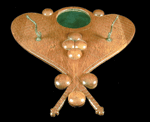
Late 19th century
coat hanger.
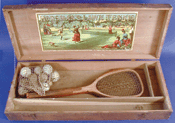
An early lawn tennis
set, wooden box manufactured by Horsman's Lawn Tennis. (Unless noted otherwise, photos courtesy of Albert
Ritzenberg.)
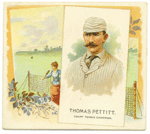
Post card of 1889
tennis
world champion.
(Courtesy Richard North, www.geocities.com/team10s)
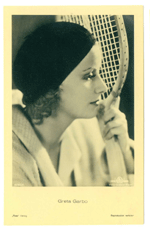
Greta Garbo posed
for this tennis postcard. (All postcard photos courtesy Richard North.)
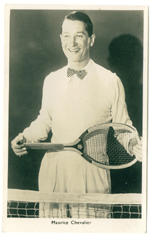
Maurice Chevalier,
another star on a tennis-themed postcard.
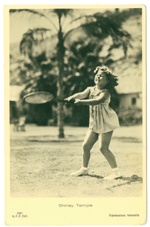
Photo postcard of
Shirley Temple.
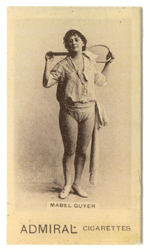
The earliest example
of a cigarette card featuring actress Mable Guyer.

1880s Extreme Lob
racquet.
All early racquets sported
this lopsided design.
(Courtesy Rolf Jaeger,
www.tennisheritage.com)
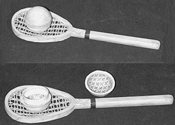
Tennis racquet and
ball candy container, 1910-1920.
(Photo, Greg Hall.)
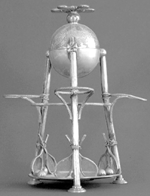
Ca. 1890 lemon
squeezer,
10" x 6" x 6".
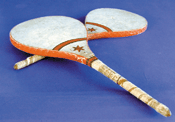
Two of the earliest
racquets, or battoir, with parchment heads.
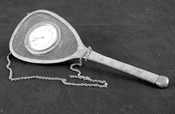
1880 brass clock. |